Water Deer Reproduction - Birth
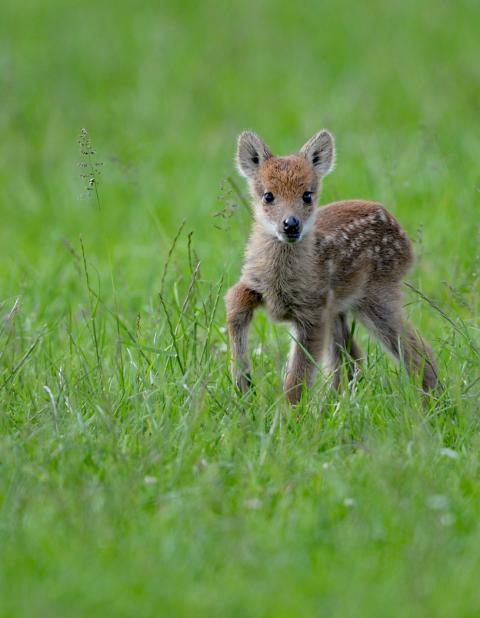
Mating in winter and a gestation of about six months results in fawns born during the late spring or early summer, and there are several evolutionary drivers behind this strategy. As hider species, deer fawns need long vegetation in which to lie-up, and being born too early in the year would reduce the availability of cover. Equally, food starts becoming more abundant as spring draws on, leaving the mother in good condition (for milk production) at the point of parturition, and there's plenty of food around for the fawn once it's old enough to take solids. Finally, the weather is unlikely to be very wet and cold, which can influence deer fawn survival.
Most fawns are born between mid-May and mid-June, with some later litters into early July. At Branféré, Dubost and colleagues noted that most births (95%) took place between 18th May and 20th June, tending to be clustered within years: on average 30th May in 2003; 1-2 June 2004; and 27-28th May 2005. Overall, however, the average was 30th to 31st May, with no significant difference among years. At the Shengzhou Chinese Water Deer Breeding Center in Zhejiang Province, between May and July 2004, Yan-Hong Li and Jie Hu observed that most (73%) births occurred between 3rd and 19th June. Among the Branféré records, only one very early birth was recorded (13th May) and three late ones (up to 27th July). On 2nd August 2019, Sharon Scott photographed a doe tending to a very small fawn, implying that there may be occasional litters born very late in July in the wild, too. Endi Zhang recorded births as early as 10th May at Whipsnade, although most were between 25th and 30th May, with 95% of fawns having been born by 19th June. In his Ph.D. thesis, Zhang compared this with a wild Chinese population at Yancheng where most births occurred between 30th May and 4th June, with 95% of births complete by 30th June. The earliest birthing record I have come across was given by Valerius Geist. In his Deer of the World, published in 1998, Geist noted that Berlin Zoo had recorded births as early as late April. I have one unconfirmed report from a stalker in Norfolk of a doe with a two- or three-week-old fawn in late February 2017, but know of no confirmed births earlier than April.
While studying the reintroduced population of water deer at the Pudong New Area of Shanghai for his master's at East China Normal University, Fen Yan Ma observed that fawning date advanced as females aged. In other words, younger females gave birth later than older ones. Similarly, Mauget and Mauget found that adult females (i.e., those more than two years old) at Branféré gave birth around 18 days earlier than yearling does. This would seem to substantiate reports discussed previously of older does mate earlier than younger ones.
As parturition approaches, females begin to present with a heavily distended abdomen, and this can complicate moving around. At Whipsnade, Stadler wrote:
"In many females in late pregnancy, running was clearly impeded, and it was felt that this situation may potentially have serious consequences for the performing of flight behaviour in the wild."
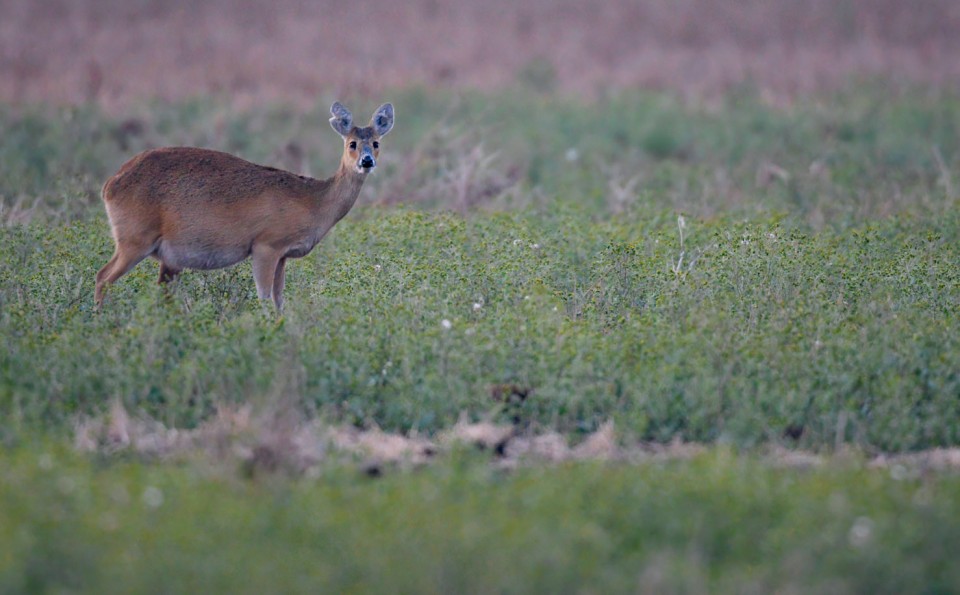
Based on his camera trap footage at Woodwalton Fen, Arnold Cooke recounted how heavily pregnant females negotiating flooded deer paths at Woodwalton were "noticeably cautious and unsteady" in Muntjac and Water Deer. Similarly, while I have not noticed heavily pregnant does to be any less likely to flee from disturbance, my experience has been that they are slower to rise and negotiate objects such as fences, and may flee shorter distances.
Along with substantially increased girth, enlarged mammary glands are also indicative of impending parturition.
Birthing preparation
They are secretive species that typically lives in dense habitats, so there are only a handful of reports of the birthing process, and, to the best of my knowledge, these all come from captivity. The earliest record of a water deer birth that I'm aware of in the literature was a doe having three fawns at the Château Beaujardin in France on 5th June 1877, following a successful mating with a stud buck sent over from the Zoological Society of London. Unfortunately, there are scant details of this parturition, and the following overview is drawn from two particularly detailed reports. One comes from Stefan Stadler's Ph.D. research at Whipsnade and involves three fawns born to a single tagged female. The second is from Raymond Chaplin, based on his observations of two does kept in his garden during the late 1960s.

Sharon Scott has suggested to me that pregnant does she has observed have seemed to pick an area in which to give birth as she'll see them persistently in the location in the run up to dropping their fawns. Perhaps in a similar vein, in a 2008 paper to Contemporary Problems in Ecology, Hyuk-Soo Kwon and colleagues reported that, in South Korea:
"... predation of [water deer] calves by [leopard cats] and [raccoon dogs] have driven female [water deer] to calve close to roads and humans, which these predators are more apt to avoid."
Stadler and Chaplin, by contrast, observed no preferences among the does at Whipsnade or Woburn. Fawns were recovered at the park in open fields, small conifer woodlands, nettle patches, bushes and thistle stalks; essentially, all microclimates available to the deer. Chaplin commented, however, that this is based on the fawns located, and some may have been better hidden and evaded recording.
Chaplin noted how the nipples and mammary glands on his captive females became increasingly distended in the fortnight before birth, and there may be some behavioural changes as well. Stadler reported that does move around more on the day of the birth; sometimes just pacing a fence line for half an hour or so, or even moving around the whole study area over the course of a few hours. During this time, they moved in an uncomfortable manner and appeared nervous. Centre d'Écologie générale de Brunoy naturalist Francois Feer observed that the doe in his captive group spent more time alone immediately prior to birth. This female was found on her own on 77% of occasions just prior to fawning, compared with just over 50% after the fawn was born. It is well known that females of other deer isolate themselves ahead of giving birth, the larger species leaving the herd to have their young, and all does I have observed with recently born fawns have been on their own. That said, water deer do not appear to be prone to conviviality under most circumstances, although Raymond Chaplin wrote of how one of his does remained with their captive buck even as labour began, at which point they separated the two.
Giving birth
In his 1977 book, Deer, Chaplin described finding one of his does, "Pippa", in labour shortly after 4AM, 'short bouts of low amplitude contractions passing across her abdomen'. As Stadler noted among the does he watched giving birth, this female stood and laid down repeatedly, changing her position several times as the birth approached. She settled, dilated, and her waters broke about 30 minutes later; birth commenced about 10 minutes after that. The head of the foetus appeared about 45 minutes after labour commenced and the fawn was born about 10 minutes later, suggesting about an hour from contractions starting to birth. Chaplin noted that when presenting correctly, fawns are born headfirst, the head lying on their outstretched front legs. During the birth Pippa was seen to undertake some mild stretching and straining, but the birth seemed considerably less difficult for her than Chaplin's second doe, "Becky", who "would strain for several seconds at a time with hind-legs and neck extended". Stadler's doe and Pippa both gave birth lying down, while Becky stood up:
"... she gave three long thrusts, within half a minute of each of which expelled the foetus several centimetres. She then rose and the foetus enclosed in the sac fell clear. As it hit the ground, the foetus was struggling vigorously and she swiftly turned on it, bit through the membranes, and licked the struggling fawn vigorously. She lay down with it and groomed it almost continuously for several minutes ..."
Once Pippa's first fawn was out, she licked it and then stood up, snapping the umbilical cord, before laying back down and proceeding to wash the newborn. Stadler described similar behaviour at Whipsnade, the doe giving birth while lying down and immediately licking the fawn clean; standing caused the umbilical cord to rip. In his Ph.D. thesis, Endi Zhang quoted Chaplin's book saying that the fawn is licked nearly continuously for the first 30 minutes after birth, and in his research notes Chaplin commented how the first fawn is licked in preparation for delivery of the second.
Stadler recorded that fawns were trying to get to their feet within 45 minutes of birth and made their first attempt to suckle at between 60 and 75 minutes old. Chaplin, by contrast, noted that Pippa's first fawn was suckling within 10 minutes of birth, despite the fawns not generally being on their feet until they were between 50 and 67 minutes old. While suckling, the mother licked the perianal region of the fawn intensively, and Pippa gave birth to her second fawn while grooming and suckling the first. She proceeded to ignore the second fawn, focussing all her attention on the first, until it was within a few centimetres of her, at which point she cleaned and suckled it. In Li and Hu's captive population at Shengzhou, singletons started suckling around 35 minutes after birth, while for twins it was closer to 40 minutes, triplets 45 minutes and quadruplets almost an hour; in one case a fawn in a litter of four didn't suckle until 78 minutes after birth. The time to being able to stand also varied, albeit less pronounced: singletons took 27 mins, twins 32 minutes, triplets 29 minutes and quadruplets 65 minutes. In essence, among this population, fawns were standing within about half an hour and suckling within 40 minutes, unless they're quadruplets, when both activities it may take an hour or more.
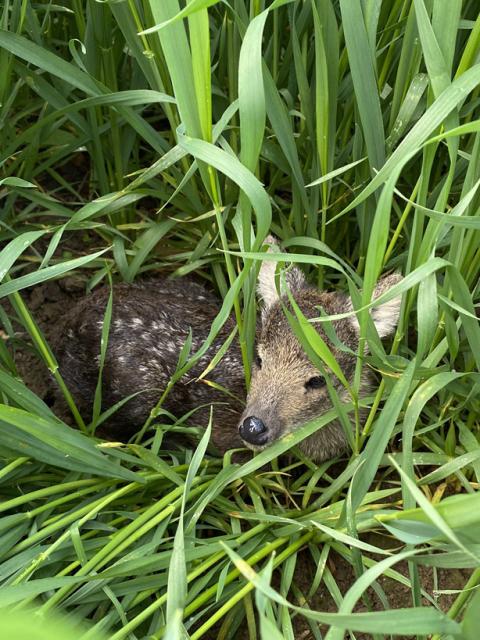
In Pippa's case, the afterbirth was passed about 15 minutes after the second fawn, and she spent about half an hour eating it before grooming herself thoroughly. Becky didn't pass her afterbirth until about four hours after her first fawn was born, and she didn't eat it all, but her second fawn was stillborn and this may have changed her behaviour. Becky did eat some parts of the umbilicus that she found on the ground the following day. In Stadler's subject, the afterbirth was passed two hours and 40 minutes after the first fawn and the mother immediately started eating it, nibbling at it over the course of the next couple of hours. Interestingly, in June 2020, Sharon Scott described seeing a doe carrying the afterbirth to the other side of the field in which it had just given birth, appearing to discard it in a hedge before returning to her fawns.
In common with most mammals, the first few hours after birth typically finds the fawns asleep. Chaplin observed that after being cleaned and suckled, Pippa's fawns would sleep for about 45 minutes before walking up to suckle and make short investigatory trips. Overall, they slept for most of the following morning. At Whipsnade, Stadler found the first attempt at running by the fawn was just under three hours after birth. There was much getting up by the doe, moving a few metres followed by her fawn(s) and lying down again - the family moved every six to eight minutes. Indeed, in Muntjac and Water Deer, Arnold Cooke notes that fawns may move 100 metres (330 ft.) in their first day, the litter becoming quite widely dispersed during that time. While following their mother, fawns moved slowly about a metre or so behind, frequently stumbling and falling during the first few hours postpartum. Stadler didn't hear any vocalisations between the mother and fawns in the hours immediately after birth, while Chaplin described a "soft low squeak" (a mild distress call) emitted by Becky's first fawn as it struggled to suckle.
At Château Beaujardin, one of the triplets born to their captive doe was still born, and similarly one of Becky's twins presented in breach (i.e., feet first) and died during birth. Stillbirth and hypothermia combined were the most significant source of mortality in fawns less than three days old at Woburn, suggesting that the former may not be uncommon where multiple births are present. We have no detail of how the French doe responded to the body, but Chaplin's experience with Becky and a mother of triplets at Woburn was that stillborn fawns generated no interest from the dam. Becky paid no attention whatsoever to the dead fawn, and the stillborn fawn at Woburn showed no indication of having been groomed. All reports I have come across suggest live fawns are groomed immediately after birth, and this is echoed by Cooke in his 2019 book. When presenting correctly, fawns are born headfirst with the head lying on their outstretched front legs. One study at Shengzhou in China found that 84% of fawns presented this way.
We don't have much data on when in the 24-hour cycle fawns tend to be born, although births may be primarily during the day. At Whipsnade Stadler observed newborns at all times of the day but noted that there seemed to be a preference for giving birth between 10AM and midday. Based on 16 litters found at Whipsnade in the 1960s, plus two births observed there, two at Woburn and two in their garden, Chaplin noted that most fawns were born in the early hours, and none were seen during the afternoon. Yan-Hong Li and Jie Hu's study at the Shengzhou Chinese Water Deer Breeding Center in China's Zhejiang Province recorded just under three-quarters of births occurring "during daylight hours" in June, although it must be remembered that nights are short.
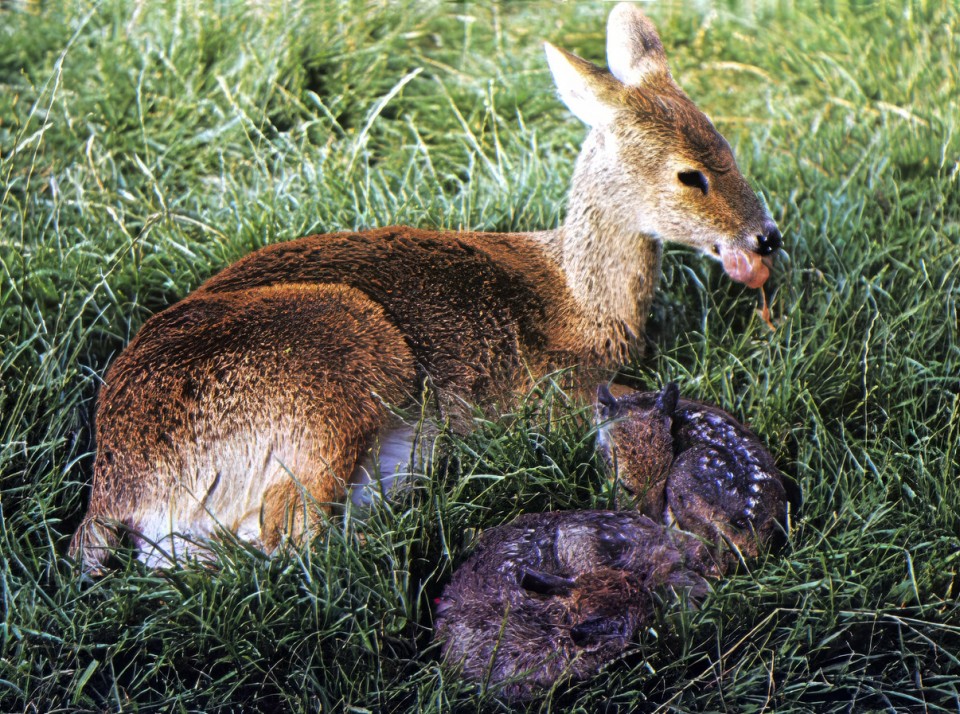
There may also be a significant delay between the delivery of individuals within the same litter. A fairly short period had passed between the presentation of fawns for both Pippa and Becky, while Stadler made no special mention of protracted inter-birthing periods and Li and Hu observed that fawns were typically born about an hour after the dam's waters broke, the second fawns 15 to 20 minutes after the first, and the third fawn around 30 minutes after the second. In a small captive population in Shanghai, however, Helin Sheng recorded one doe give birth to twins on 1st June 1989, and drop a third two days later, while a second individual delivered two on 7th June and a third the following day.
Size at birth
Typically, fawns weigh between 600 g (21 oz.) and 1kg (35 oz.) at birth, averaging around 800 g (28 oz.), but as one would anticipate, birth weight varies according to the age (and invariably overall condition) of the mother, the sex of the foetus and the litter size. James Kirkwood and his co-workers found that birth weights of 79 fawns caught and tagged at Whipsnade during the 1980s ranged from 625 to 1,050 grams (22-37 oz.), while Robert Lawrence, in his two-acre broadleaf woodland enclosure, noted the heaviest fawn he found was a buck weighing just under 800 g (28 oz.) and the lightest a doe of 400 g, both born to the same two-year-old dam. In their Shenzhou Breeding Center study population, Li and Hu observed average birth weight decline as litter size increased. Single fawns averaged 818 g (range of 635-1,055 g), twins averaged 769 g (500-1,025 g), triplets 700 g / 25 oz. (455-875 g) and quadruplets 561 g / 20 oz. (410-750 g). Gérard Dubost and his team at Branféré Zoological Park observed the same trend of singleton fawns being heavier than twins, which were heavier than triplets, although this was only statistically significant for male fawns. Overall, mature mothers produced heavier male fawns than did juvenile or yearling dams. Interestingly, the researchers also identified a consistent and statistically significant bias towards females being heavier than males at birth (900 g/32 oz. vs. 966 g / 34 oz.) and at 6 months old (10 kg / 22 lbs. vs. 11 kg / 24 lbs.), but not at 18 months (both 14-15 kgs / 32 lbs), suggesting males "catch up" in their growth.
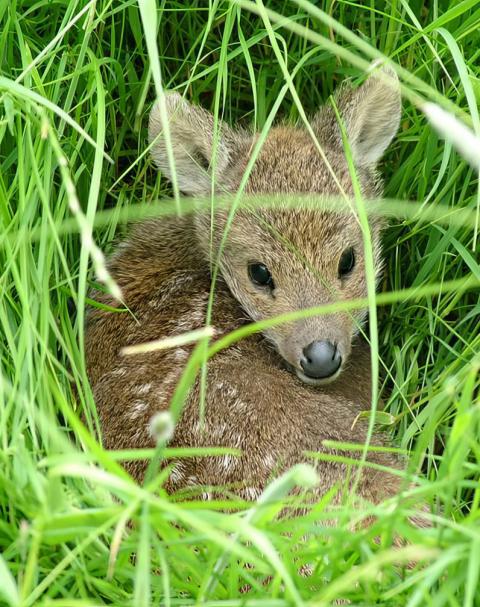
In their 2007 Chinese paper to the Journal of Animal Husbandry and Veterinary Medicine on the requirements of water deer being raised in captivity at the Dafeng Milu Nature Reserve, Hua Shen and his team present average measurements of fawns at birth, based on ten newborns. The fawns averaged 850 grams (1.9 lbs.), were 22.5 cm (9 in.) at the shoulder, 30 cm (12 in.) long and had a 2.4 cm (1 in.) long tail. The individual stillborn at Château Beaujardin in 1877 was about 45 cm (18 in.) in length and weighed 1,175 g (2.6 lbs). One of the other Beaujardin fawns, a female, died shortly after birth and was sent to London for analysis. In a letter to the Proceedings of the Zoological Society of London, published in 1877, Alfred Garrod described in detail the morphology of this fawn. The animal was 40.6 cm (16 in.) from tip of nose to tip of tail, the latter being 2.4 cm in length, and was 30 cm at the shoulder. The milk incisors and lower canines were cut at birth, as was the sharp small upper canine, while the milk molars were in place and partly covered by a layer of mucous membrane.
As mentioned earlier, grooming happens immediately after birth and is the method by which the dam removes the birthing membranes and cleans up her fawn, but it also an important element of bonding (see also Wash and brush-up). In Deer, Raymond Chaplin notes how grooming appears to be a precondition of acceptance and/or recognition by the dam, and fawns remaining ungroomed or groomed very little in the hours after birth appear to be rejected by their mother. Indeed, in his unpublished research note, Chaplin discusses his view that the first six hours or so after birth are critical for the mother-fawn bond to become established, and that displacement of the mother or handling of the fawns within this period may result in fawn rejection. Under normal circumstances, the dam probably doesn't leave the fawns during this time. Chaplin described watching one doe approach her recent-tagged fawn at Whipsnade, sniff at the tag and shy away; this happened several times before the doe eventually allowed the fawn to suckle.
Grooming may help stimulate the fawn's skin follicles to secrete the lipids and esters that serve to condition and waterproof the coat. Indeed, Chaplin described how a properly groomed coat is thoroughly dry, shiny, flat and often feels greasy, and the underfur remained warm and dry even while water was running off the outer guard hairs. It seems likely, however, that grooming's most significant function is to help impart scent onto the fawn, and anecdotal observations suggest that females identify their offspring using scent. Sharon Scott has described watching a mother follow a scent trail to her hidden fawn and, during tagging studies at Woburn, Chaplin recounted how three dams were showing interest in three fawns, each found separately, being ear-tagged by researchers. As each fawn was released, Chaplin noticed that all three does would approach and sniff at it, but only one would subsequently groom and suckle it.

At birth, fawns have either a russet-brown or stone-grey coat with lighter/white spots distributed in parallel lines. Spaced about four centimetres (1.5 in.) apart, the spots run in longitudinal lines from the base of the neck to the tail. Interestingly, the upper line of spots on the fawn's coat is more distinctive than the two lower ones, which are shorter and more irregular. In his description of the stillborn female fawn, Garrod noted of the coat:
"The spots are not distinct because they are not produced by the presence of hairs which are white throughout, but by dark reddish hairs tipped with white for not more than one sixth of their length."